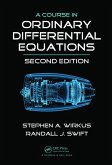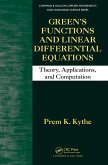Steven G. Krantz
Differential Equations (eBook, ePUB)
Theory,Technique and Practice with Boundary Value Problems
73,95 €
73,95 €
inkl. MwSt.
Sofort per Download lieferbar

37 °P sammeln
73,95 €
Als Download kaufen

73,95 €
inkl. MwSt.
Sofort per Download lieferbar

37 °P sammeln
Jetzt verschenken
Alle Infos zum eBook verschenken
73,95 €
inkl. MwSt.
Sofort per Download lieferbar
Alle Infos zum eBook verschenken

37 °P sammeln
Steven G. Krantz
Differential Equations (eBook, ePUB)
Theory,Technique and Practice with Boundary Value Problems
- Format: ePub
- Merkliste
- Auf die Merkliste
- Bewerten Bewerten
- Teilen
- Produkt teilen
- Produkterinnerung
- Produkterinnerung

Bitte loggen Sie sich zunächst in Ihr Kundenkonto ein oder registrieren Sie sich bei
bücher.de, um das eBook-Abo tolino select nutzen zu können.
Hier können Sie sich einloggen
Hier können Sie sich einloggen
Sie sind bereits eingeloggt. Klicken Sie auf 2. tolino select Abo, um fortzufahren.

Bitte loggen Sie sich zunächst in Ihr Kundenkonto ein oder registrieren Sie sich bei bücher.de, um das eBook-Abo tolino select nutzen zu können.
Differential Equations: Theory, Technique, and Practice with Boundary Value Problems presents classical ideas and cutting-edge techniques for a contemporary, undergraduate-level, one- or two-semester course on ordinary differential equations. Authored by a widely respected researcher and teacher, the text covers standard topics such as partial diff
- Geräte: eReader
- mit Kopierschutz
- eBook Hilfe
Andere Kunden interessierten sich auch für
![Differential Equations (eBook, PDF) Differential Equations (eBook, PDF)]() Steven G. KrantzDifferential Equations (eBook, PDF)73,95 €
Steven G. KrantzDifferential Equations (eBook, PDF)73,95 €![Differential Equations with MATLAB (eBook, ePUB) Differential Equations with MATLAB (eBook, ePUB)]() Mark McKibbenDifferential Equations with MATLAB (eBook, ePUB)56,95 €
Mark McKibbenDifferential Equations with MATLAB (eBook, ePUB)56,95 €![Introduction to Functional Equations (eBook, ePUB) Introduction to Functional Equations (eBook, ePUB)]() Prasanna K. SahooIntroduction to Functional Equations (eBook, ePUB)73,95 €
Prasanna K. SahooIntroduction to Functional Equations (eBook, ePUB)73,95 €![A Course in Ordinary Differential Equations (eBook, ePUB) A Course in Ordinary Differential Equations (eBook, ePUB)]() Stephen A. WirkusA Course in Ordinary Differential Equations (eBook, ePUB)69,95 €
Stephen A. WirkusA Course in Ordinary Differential Equations (eBook, ePUB)69,95 €![Handbook of Linear Partial Differential Equations for Engineers and Scientists (eBook, ePUB) Handbook of Linear Partial Differential Equations for Engineers and Scientists (eBook, ePUB)]() Andrei D. PolyaninHandbook of Linear Partial Differential Equations for Engineers and Scientists (eBook, ePUB)216,95 €
Andrei D. PolyaninHandbook of Linear Partial Differential Equations for Engineers and Scientists (eBook, ePUB)216,95 €![Green's Functions and Linear Differential Equations (eBook, ePUB) Green's Functions and Linear Differential Equations (eBook, ePUB)]() Prem K. KytheGreen's Functions and Linear Differential Equations (eBook, ePUB)56,95 €
Prem K. KytheGreen's Functions and Linear Differential Equations (eBook, ePUB)56,95 €![Handbook of Exact Solutions for Ordinary Differential Equations (eBook, ePUB) Handbook of Exact Solutions for Ordinary Differential Equations (eBook, ePUB)]() Valentin F. ZaitsevHandbook of Exact Solutions for Ordinary Differential Equations (eBook, ePUB)216,95 €
Valentin F. ZaitsevHandbook of Exact Solutions for Ordinary Differential Equations (eBook, ePUB)216,95 €-
-
-
Differential Equations: Theory, Technique, and Practice with Boundary Value Problems presents classical ideas and cutting-edge techniques for a contemporary, undergraduate-level, one- or two-semester course on ordinary differential equations. Authored by a widely respected researcher and teacher, the text covers standard topics such as partial diff
Dieser Download kann aus rechtlichen Gründen nur mit Rechnungsadresse in A, B, BG, CY, CZ, D, DK, EW, E, FIN, F, GR, HR, H, IRL, I, LT, L, LR, M, NL, PL, P, R, S, SLO, SK ausgeliefert werden.
Produktdetails
- Produktdetails
- Verlag: Taylor & Francis eBooks
- Seitenzahl: 480
- Erscheinungstermin: 7. Oktober 2015
- Englisch
- ISBN-13: 9781498735049
- Artikelnr.: 58643953
- Verlag: Taylor & Francis eBooks
- Seitenzahl: 480
- Erscheinungstermin: 7. Oktober 2015
- Englisch
- ISBN-13: 9781498735049
- Artikelnr.: 58643953
- Herstellerkennzeichnung Die Herstellerinformationen sind derzeit nicht verfügbar.
Steven G. Krantz is a professor of mathematics at Washington University in St. Louis. He has written more than 175 scholarly papers and more than 65 books, including the following books published by CRC Press: Foundations of Analysis (2014), Convex Analysis (2014), Real Analysis and Foundations, Third Edition (2013), and Elements of Advanced Mathematics, Third Edition (2012). An AMS Fellow, Dr. Krantz has been a recipient of the Chauvenet Prize, Beckenbach Book Award, and Kemper Prize. He received a Ph.D from Princeton University.
Preface
1. What Is a Differential Equation?
1.1 Introductory Remarks
1.2 A Taste of Ordinary Differential Equations
1.3 The Nature of Solutions
2. Solving First-Order Equations
2.1 Separable Equations
2.2 First-Order Linear Equations
2.3 Exact Equations
2.4 Orthogonal Trajectories and Curves
2.5 Homogeneous Equations
2.6 Integrating Factors
2.7 Reduction of Order
2.7.1 Dependent Variable Missing
2.7.2 Independent Variable Missing
3. Some Applications of the First-Order Theory
3.1 The Hanging Chain and Pursuit Curves
3.1.1 The Hanging Chain
3.1.2 Pursuit Curves
3.2 Electrical Circuits
Anatomy of an Application
Problems for Review and Discovery
4. Second-Order Linear Equations
4.1 Second-Order Linear Equations with Constant Coefficients
4.2 The Method of Undetermined Coefficients
4.3 The Method of Variation of Parameters
4.4 The Use of a Known Solution to Find Another
4.5 Higher-Order Equations
5. Applications of the Second-Order Theory
5.1 Vibrations and Oscillations
5.1.1 Undamped Simple Harmonic Motion
5.1.2 Damped Vibrations
5.1.3 Forced Vibrations
5.1.4 A Few Remarks About Electricity
5.2 Newton's Law of Gravitation and Kepler's Laws
5.2.1 Kepler's Second Law
5.2.2 Kepler's First Law
5.2.3 Kepler's Third Law
Historical Note
Anatomy of an Application
Problems for Review and Discovery
6. Power Series Solutions and Special Functions
6.1 Introduction and Review of Power Series
6.1.1 Review of Power Series
6.2 Series Solutions of First-Order Equations
6.3 Ordinary Points
6.4 Regular Singular Points
6.5 More on Regular Singular Points
Historical Note
Historical Note
Anatomy of an Application
Problems for Review and Discovery
7. Fourier Series: Basic Concepts
7.1 Fourier Coefficients
7.2 Some Remarks about Convergence
7.3 Even and Odd Functions: Cosine and Sine Series
7.4 Fourier Series on Arbitrary Intervals
7.5 Orthogonal Functions
Historical Note
Anatomy of an Application
Problems for Review and Discovery
8. Laplace Transforms
8.0 Introduction
8.1 Applications to Differential Equations
8.2 Derivatives and Integrals
8.3 Convolutions
8.3.1 Abel's Mechanics Problem
8.4 The Unit Step and Impulse Functions
Historical Note
Anatomy of an Application
Problems for Review and Discovery
9. The Calculus of Variations
9.1 Introductory Remarks
9.2 Euler's Equation
9.3 Isoperimetric Problems and the Like
9.3.1 Lagrange Multipliers
9.3.2 Integral Side Conditions
9.3.3 Finite Side Conditions
Historical Note
Anatomy of an Application
Problems for Review and Discovery
10. Systems of First-Order Equations
10.1 Introductory Remarks
10.2 Linear Systems
10.3 Systems with Constant Coefficients
10.4 Nonlinear Systems
Anatomy of an Application
Problems for Review and Discovery
11. Partial Differential Equations and Boundary Value Problems
11.1 Introduction and Historical Remarks
11.2 Eigenvalues and the Vibrating String
11.2.1 Boundary Value Problems
11.2.2 Derivation of the Wave Equation
11.2.3 Solution of the Wave Equation
11.3 The Heat Equation
11.4 The Dirichlet Problem for a Disc
11.4.1 The Poisson Integral
11.5 Sturm-Liouville Problems
Historical Note
Historical Note
Anatomy of an Application
Problems for Review and Discovery
12. The Nonlinear Theory
12.1 Some Motivating Examples
12.2 Specializing Down
12.3 Types of Critical Points: Stability
12.4 Critical Points and Stability
12.5 Stability by Liapunov's Direct Method
12.6 Simple Critical Points of Nonlinear Systems
12.7 Nonlinear Mechanics: Conservative Systems
12.8 Periodic Solutions
Historical Note
Anatomy of an Application
Problems for Review and Discovery
13. Qualitative Properties and Theoretical Aspects
13.1 A Bit of Theory
13.2 Picard's Existence and Uniqueness Theorem
13.2.1 The Form of a Differential Equation
13.2.2 Picard's Iteration Technique
13.2.3 Some Illustrative Examples
13.2.4 Estimation of the Picard Iterates
13.3 Oscillations and the Sturm Separation Theorem
13.4 The Sturm Comparison Theorem
Anatomy of an Application
Problems for Review and Discovery
Appendix: Review of Linear Algebra
Bibliography
Index
1. What Is a Differential Equation?
1.1 Introductory Remarks
1.2 A Taste of Ordinary Differential Equations
1.3 The Nature of Solutions
2. Solving First-Order Equations
2.1 Separable Equations
2.2 First-Order Linear Equations
2.3 Exact Equations
2.4 Orthogonal Trajectories and Curves
2.5 Homogeneous Equations
2.6 Integrating Factors
2.7 Reduction of Order
2.7.1 Dependent Variable Missing
2.7.2 Independent Variable Missing
3. Some Applications of the First-Order Theory
3.1 The Hanging Chain and Pursuit Curves
3.1.1 The Hanging Chain
3.1.2 Pursuit Curves
3.2 Electrical Circuits
Anatomy of an Application
Problems for Review and Discovery
4. Second-Order Linear Equations
4.1 Second-Order Linear Equations with Constant Coefficients
4.2 The Method of Undetermined Coefficients
4.3 The Method of Variation of Parameters
4.4 The Use of a Known Solution to Find Another
4.5 Higher-Order Equations
5. Applications of the Second-Order Theory
5.1 Vibrations and Oscillations
5.1.1 Undamped Simple Harmonic Motion
5.1.2 Damped Vibrations
5.1.3 Forced Vibrations
5.1.4 A Few Remarks About Electricity
5.2 Newton's Law of Gravitation and Kepler's Laws
5.2.1 Kepler's Second Law
5.2.2 Kepler's First Law
5.2.3 Kepler's Third Law
Historical Note
Anatomy of an Application
Problems for Review and Discovery
6. Power Series Solutions and Special Functions
6.1 Introduction and Review of Power Series
6.1.1 Review of Power Series
6.2 Series Solutions of First-Order Equations
6.3 Ordinary Points
6.4 Regular Singular Points
6.5 More on Regular Singular Points
Historical Note
Historical Note
Anatomy of an Application
Problems for Review and Discovery
7. Fourier Series: Basic Concepts
7.1 Fourier Coefficients
7.2 Some Remarks about Convergence
7.3 Even and Odd Functions: Cosine and Sine Series
7.4 Fourier Series on Arbitrary Intervals
7.5 Orthogonal Functions
Historical Note
Anatomy of an Application
Problems for Review and Discovery
8. Laplace Transforms
8.0 Introduction
8.1 Applications to Differential Equations
8.2 Derivatives and Integrals
8.3 Convolutions
8.3.1 Abel's Mechanics Problem
8.4 The Unit Step and Impulse Functions
Historical Note
Anatomy of an Application
Problems for Review and Discovery
9. The Calculus of Variations
9.1 Introductory Remarks
9.2 Euler's Equation
9.3 Isoperimetric Problems and the Like
9.3.1 Lagrange Multipliers
9.3.2 Integral Side Conditions
9.3.3 Finite Side Conditions
Historical Note
Anatomy of an Application
Problems for Review and Discovery
10. Systems of First-Order Equations
10.1 Introductory Remarks
10.2 Linear Systems
10.3 Systems with Constant Coefficients
10.4 Nonlinear Systems
Anatomy of an Application
Problems for Review and Discovery
11. Partial Differential Equations and Boundary Value Problems
11.1 Introduction and Historical Remarks
11.2 Eigenvalues and the Vibrating String
11.2.1 Boundary Value Problems
11.2.2 Derivation of the Wave Equation
11.2.3 Solution of the Wave Equation
11.3 The Heat Equation
11.4 The Dirichlet Problem for a Disc
11.4.1 The Poisson Integral
11.5 Sturm-Liouville Problems
Historical Note
Historical Note
Anatomy of an Application
Problems for Review and Discovery
12. The Nonlinear Theory
12.1 Some Motivating Examples
12.2 Specializing Down
12.3 Types of Critical Points: Stability
12.4 Critical Points and Stability
12.5 Stability by Liapunov's Direct Method
12.6 Simple Critical Points of Nonlinear Systems
12.7 Nonlinear Mechanics: Conservative Systems
12.8 Periodic Solutions
Historical Note
Anatomy of an Application
Problems for Review and Discovery
13. Qualitative Properties and Theoretical Aspects
13.1 A Bit of Theory
13.2 Picard's Existence and Uniqueness Theorem
13.2.1 The Form of a Differential Equation
13.2.2 Picard's Iteration Technique
13.2.3 Some Illustrative Examples
13.2.4 Estimation of the Picard Iterates
13.3 Oscillations and the Sturm Separation Theorem
13.4 The Sturm Comparison Theorem
Anatomy of an Application
Problems for Review and Discovery
Appendix: Review of Linear Algebra
Bibliography
Index
Preface
1. What Is a Differential Equation?
1.1 Introductory Remarks
1.2 A Taste of Ordinary Differential Equations
1.3 The Nature of Solutions
2. Solving First-Order Equations
2.1 Separable Equations
2.2 First-Order Linear Equations
2.3 Exact Equations
2.4 Orthogonal Trajectories and Curves
2.5 Homogeneous Equations
2.6 Integrating Factors
2.7 Reduction of Order
2.7.1 Dependent Variable Missing
2.7.2 Independent Variable Missing
3. Some Applications of the First-Order Theory
3.1 The Hanging Chain and Pursuit Curves
3.1.1 The Hanging Chain
3.1.2 Pursuit Curves
3.2 Electrical Circuits
Anatomy of an Application
Problems for Review and Discovery
4. Second-Order Linear Equations
4.1 Second-Order Linear Equations with Constant Coefficients
4.2 The Method of Undetermined Coefficients
4.3 The Method of Variation of Parameters
4.4 The Use of a Known Solution to Find Another
4.5 Higher-Order Equations
5. Applications of the Second-Order Theory
5.1 Vibrations and Oscillations
5.1.1 Undamped Simple Harmonic Motion
5.1.2 Damped Vibrations
5.1.3 Forced Vibrations
5.1.4 A Few Remarks About Electricity
5.2 Newton's Law of Gravitation and Kepler's Laws
5.2.1 Kepler's Second Law
5.2.2 Kepler's First Law
5.2.3 Kepler's Third Law
Historical Note
Anatomy of an Application
Problems for Review and Discovery
6. Power Series Solutions and Special Functions
6.1 Introduction and Review of Power Series
6.1.1 Review of Power Series
6.2 Series Solutions of First-Order Equations
6.3 Ordinary Points
6.4 Regular Singular Points
6.5 More on Regular Singular Points
Historical Note
Historical Note
Anatomy of an Application
Problems for Review and Discovery
7. Fourier Series: Basic Concepts
7.1 Fourier Coefficients
7.2 Some Remarks about Convergence
7.3 Even and Odd Functions: Cosine and Sine Series
7.4 Fourier Series on Arbitrary Intervals
7.5 Orthogonal Functions
Historical Note
Anatomy of an Application
Problems for Review and Discovery
8. Laplace Transforms
8.0 Introduction
8.1 Applications to Differential Equations
8.2 Derivatives and Integrals
8.3 Convolutions
8.3.1 Abel's Mechanics Problem
8.4 The Unit Step and Impulse Functions
Historical Note
Anatomy of an Application
Problems for Review and Discovery
9. The Calculus of Variations
9.1 Introductory Remarks
9.2 Euler's Equation
9.3 Isoperimetric Problems and the Like
9.3.1 Lagrange Multipliers
9.3.2 Integral Side Conditions
9.3.3 Finite Side Conditions
Historical Note
Anatomy of an Application
Problems for Review and Discovery
10. Systems of First-Order Equations
10.1 Introductory Remarks
10.2 Linear Systems
10.3 Systems with Constant Coefficients
10.4 Nonlinear Systems
Anatomy of an Application
Problems for Review and Discovery
11. Partial Differential Equations and Boundary Value Problems
11.1 Introduction and Historical Remarks
11.2 Eigenvalues and the Vibrating String
11.2.1 Boundary Value Problems
11.2.2 Derivation of the Wave Equation
11.2.3 Solution of the Wave Equation
11.3 The Heat Equation
11.4 The Dirichlet Problem for a Disc
11.4.1 The Poisson Integral
11.5 Sturm-Liouville Problems
Historical Note
Historical Note
Anatomy of an Application
Problems for Review and Discovery
12. The Nonlinear Theory
12.1 Some Motivating Examples
12.2 Specializing Down
12.3 Types of Critical Points: Stability
12.4 Critical Points and Stability
12.5 Stability by Liapunov's Direct Method
12.6 Simple Critical Points of Nonlinear Systems
12.7 Nonlinear Mechanics: Conservative Systems
12.8 Periodic Solutions
Historical Note
Anatomy of an Application
Problems for Review and Discovery
13. Qualitative Properties and Theoretical Aspects
13.1 A Bit of Theory
13.2 Picard's Existence and Uniqueness Theorem
13.2.1 The Form of a Differential Equation
13.2.2 Picard's Iteration Technique
13.2.3 Some Illustrative Examples
13.2.4 Estimation of the Picard Iterates
13.3 Oscillations and the Sturm Separation Theorem
13.4 The Sturm Comparison Theorem
Anatomy of an Application
Problems for Review and Discovery
Appendix: Review of Linear Algebra
Bibliography
Index
1. What Is a Differential Equation?
1.1 Introductory Remarks
1.2 A Taste of Ordinary Differential Equations
1.3 The Nature of Solutions
2. Solving First-Order Equations
2.1 Separable Equations
2.2 First-Order Linear Equations
2.3 Exact Equations
2.4 Orthogonal Trajectories and Curves
2.5 Homogeneous Equations
2.6 Integrating Factors
2.7 Reduction of Order
2.7.1 Dependent Variable Missing
2.7.2 Independent Variable Missing
3. Some Applications of the First-Order Theory
3.1 The Hanging Chain and Pursuit Curves
3.1.1 The Hanging Chain
3.1.2 Pursuit Curves
3.2 Electrical Circuits
Anatomy of an Application
Problems for Review and Discovery
4. Second-Order Linear Equations
4.1 Second-Order Linear Equations with Constant Coefficients
4.2 The Method of Undetermined Coefficients
4.3 The Method of Variation of Parameters
4.4 The Use of a Known Solution to Find Another
4.5 Higher-Order Equations
5. Applications of the Second-Order Theory
5.1 Vibrations and Oscillations
5.1.1 Undamped Simple Harmonic Motion
5.1.2 Damped Vibrations
5.1.3 Forced Vibrations
5.1.4 A Few Remarks About Electricity
5.2 Newton's Law of Gravitation and Kepler's Laws
5.2.1 Kepler's Second Law
5.2.2 Kepler's First Law
5.2.3 Kepler's Third Law
Historical Note
Anatomy of an Application
Problems for Review and Discovery
6. Power Series Solutions and Special Functions
6.1 Introduction and Review of Power Series
6.1.1 Review of Power Series
6.2 Series Solutions of First-Order Equations
6.3 Ordinary Points
6.4 Regular Singular Points
6.5 More on Regular Singular Points
Historical Note
Historical Note
Anatomy of an Application
Problems for Review and Discovery
7. Fourier Series: Basic Concepts
7.1 Fourier Coefficients
7.2 Some Remarks about Convergence
7.3 Even and Odd Functions: Cosine and Sine Series
7.4 Fourier Series on Arbitrary Intervals
7.5 Orthogonal Functions
Historical Note
Anatomy of an Application
Problems for Review and Discovery
8. Laplace Transforms
8.0 Introduction
8.1 Applications to Differential Equations
8.2 Derivatives and Integrals
8.3 Convolutions
8.3.1 Abel's Mechanics Problem
8.4 The Unit Step and Impulse Functions
Historical Note
Anatomy of an Application
Problems for Review and Discovery
9. The Calculus of Variations
9.1 Introductory Remarks
9.2 Euler's Equation
9.3 Isoperimetric Problems and the Like
9.3.1 Lagrange Multipliers
9.3.2 Integral Side Conditions
9.3.3 Finite Side Conditions
Historical Note
Anatomy of an Application
Problems for Review and Discovery
10. Systems of First-Order Equations
10.1 Introductory Remarks
10.2 Linear Systems
10.3 Systems with Constant Coefficients
10.4 Nonlinear Systems
Anatomy of an Application
Problems for Review and Discovery
11. Partial Differential Equations and Boundary Value Problems
11.1 Introduction and Historical Remarks
11.2 Eigenvalues and the Vibrating String
11.2.1 Boundary Value Problems
11.2.2 Derivation of the Wave Equation
11.2.3 Solution of the Wave Equation
11.3 The Heat Equation
11.4 The Dirichlet Problem for a Disc
11.4.1 The Poisson Integral
11.5 Sturm-Liouville Problems
Historical Note
Historical Note
Anatomy of an Application
Problems for Review and Discovery
12. The Nonlinear Theory
12.1 Some Motivating Examples
12.2 Specializing Down
12.3 Types of Critical Points: Stability
12.4 Critical Points and Stability
12.5 Stability by Liapunov's Direct Method
12.6 Simple Critical Points of Nonlinear Systems
12.7 Nonlinear Mechanics: Conservative Systems
12.8 Periodic Solutions
Historical Note
Anatomy of an Application
Problems for Review and Discovery
13. Qualitative Properties and Theoretical Aspects
13.1 A Bit of Theory
13.2 Picard's Existence and Uniqueness Theorem
13.2.1 The Form of a Differential Equation
13.2.2 Picard's Iteration Technique
13.2.3 Some Illustrative Examples
13.2.4 Estimation of the Picard Iterates
13.3 Oscillations and the Sturm Separation Theorem
13.4 The Sturm Comparison Theorem
Anatomy of an Application
Problems for Review and Discovery
Appendix: Review of Linear Algebra
Bibliography
Index







